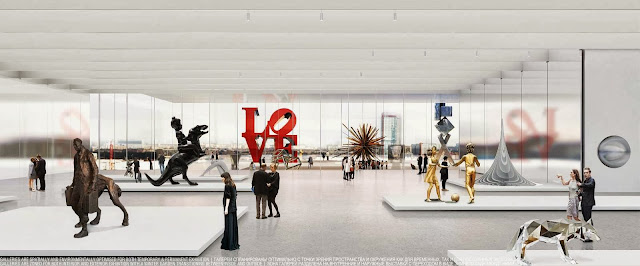Three finalists of the International Competition for the architectural concept for the new building for National Centre forContemporary Arts (NCCA) at Khodynskoe Pole in Moscow have been announced.
Heneghan PengArchitects (Ireland)
This proposal positions the NCCA building as a vertical element at the centre of Khodynskoe Pole rising above Aviapark. Given the scale and relative sparsenesss of activities in the area, the aim is to concentrate the flow of people to generate an excitement and energy which can then expand into other areas as the park develops.
In this proposal, the exhibition spaces are designed as a series of stacked galleries allowing people to either visit a particular gallery of interest or browse through the entire collection. The landscape proposal responds to the scale of the park, and to its history as an airfield. The Runways are proposed as the exception to this intense nature, becoming home to a new range of activities: ice rinks, formal flower gardens, and skateboard areas.
The organisational strategy is driven by the following considerations:
- Locating the exhibition spaces as a destination at the top of the Building
- Utilising the NCCA building to make a focal point of activities on the ground floor
- Creating an awareness of all of the Museum’s activities for the visitor.
There are a multitude of possible routes to facilitate a multitude of visitors, from browsers to specialists. A multi-level Foyer allows the design to negotiate the various site and service challenges while responding to the possibilities offered by the park. Exhibition spaces are designed as flexible space, as trays of varying sizes and heights which can accommodate a variety of exhibitions.
MEL (Russia)
The basic functional spaces of the Centre are placed on a single stylobate — ‘the hill’. A landscaped park is laid out on its roof, with pavilions housing the exhibition halls for the permanent collections and temporary displays, the educational and media centre, café club and artists’ residences.
The roof top paving employs several textures, changing where different zones meet, thus emphasising the unique character of each zone. The ground floor forms a single communicational space, linking up with the exhibition halls and the pavilions on the roof.
This structure allows for a highly flexible exploitation of space, utilising differing scenarios for the movement of visitors among the exhibits. Additionally, entrance into the park may be arranged from any of the pavilions, enabling their use in independent large-scale exhibition projects.
The pavilions have an austere appearance, resembling natural geological features. Clad in natural stone tiles and polished concrete, their multi-layered and complex structure will evoke cliff formations. The park space provides an important environment for the mulling over of recent cultural experiences, a transitional space between the territory of art and the city environment.
Nieto Sobejano Arquitectos (Spain)
Contrasting with the homogeneity that the global civilisation seems to impose, the NCCA aims to embrace the character of the Russian culture, bringing life and movement into a new and upcoming urban area of Moscow. Following the simplicity of the geometric laws through which artists, engineers, and architects from the past were capable of generating complexity out of an elementary combinatorial process, we begin with a geometric pattern that takes an identical cylindrical form. The permutations of this form in different volumes create series of spaces that can be connected in different ways.
A non-hierarchical sequence of exhibition rooms is configured on different levels and heights within these large cultural silos. Whilst the exhibition program is divided vertically, the building sees a radical horizontal cut — a mid-air connection — conceived as a large interior public street. The exhibition halls differ in heights, though there is no strict differentiation between them. Four silos are dedicated to the permanent collections and the other three are allocated to temporary exhibitions. However, the flexible nature of these rooms allows for various different spatial configurations.
The artist’s workshops and residences are located on the upper floors of the last silo, which also incorporates the parking. The largest volume, situated by the major public entrance, houses the main auditorium. Conceived as a “Black Box”, this versatile platform offers a dramatic setting for theatrical performances, conferences, films, and unique audiovisual exhibitions. The striking façade panels facing the park enable media installations that have been specifically conceived for this purpose and context.
The NCCA will be a centre for artistic creation, a place for interaction, a lively public space that will encourage the expression and exchange of ideas. The visiting experience will be a unique one, regardless of whether its purpose is to see an installation, access exhibitions, visit the Art Café, spend time in the media library, wait for a performance to begin in the Black Box, or simply to look out onto Khodynskoe Park and the city of Moscow.















